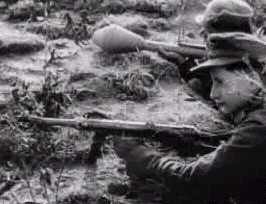 Infanteriewaffen,
Schützenwaffen
Infanteriewaffen,
Schützenwaffen
 Infanteriewaffen,
Schützenwaffen
Infanteriewaffen,
Schützenwaffen
Due to the nature of this site as an anti-tank weapons page, the
infantry small arms can only be covered in a somewhat concise form. Small
arms such as rifles or submachine guns can hardly be called anti-tank weapons;
they can be of use against non-armored and very lightly armored vehicles
only. Nevertheless, the most numerous small arms shall be rudimentarily
covered here, not the least because they accompanied the AT-weapons.
Another AT use of sorts is the employment of snipers dedicated to neutralizing
a tanks crew, usually the commander. Tank commanders preferred to ride
"unbuttoned", i.e., leaning out of the hatch, unless the circumstances
absolutely prohibited this, because of the poor visibility from inside
the tank. The russians took advantage of this and trained snipers especially
for shooting such exposed crewmen. Such "Anti-Tank" snipers were then incorporated
into regular infantry units. Although the germans did not have such an
institutionalised improvised AT-method, their snipers just like any other
could act in such a way if the tactical situation of a battle invited this.
 The
famous Luger P 08 had been the official german army pistol since
it's introduction in August 1908 and remained in service until the end
of WW II, although production ceased in favor of it's successor model,
the P 38, in November 1942 because Luger was a comparably expensive
(at 32.- RM), complicated to produce and despite it's reputation actually
a rather
The
famous Luger P 08 had been the official german army pistol since
it's introduction in August 1908 and remained in service until the end
of WW II, although production ceased in favor of it's successor model,
the P 38, in November 1942 because Luger was a comparably expensive
(at 32.- RM), complicated to produce and despite it's reputation actually
a rather  unreliable
and impractical weapon. The weapon's fathers were Hugo Borchardt who invented
the famous knee-joint breech and Georg Luger who designed this into the
weapon. At a typical length of 22cm the weapon weighed 870g empty and had
a magazine capacity of 8 rounds. It fired the 9mm Parabellum ammunition
at a Vo of 340m/s. Wartime production of the P 08 was 412,898. The
successor and most numerous german pistol in WW II was the Selbstladepistole
Walther P 38 ("self-loading pistol Walther"). It was the result of
developments that lasted from 1935 until 1937. It is an automatic pistol
with the caliber 9mm Parabellum with a length of 21.6cm, an empty weight
of 800g and a magazine capacity of 8rounds. Fired from the P 38
the bullet reaches a Vo of 355m/s. Germany produced a total of 1.2 million
P38 pistols during the war. A wide range of private-purchase, non-issue
pistols was also used.
unreliable
and impractical weapon. The weapon's fathers were Hugo Borchardt who invented
the famous knee-joint breech and Georg Luger who designed this into the
weapon. At a typical length of 22cm the weapon weighed 870g empty and had
a magazine capacity of 8 rounds. It fired the 9mm Parabellum ammunition
at a Vo of 340m/s. Wartime production of the P 08 was 412,898. The
successor and most numerous german pistol in WW II was the Selbstladepistole
Walther P 38 ("self-loading pistol Walther"). It was the result of
developments that lasted from 1935 until 1937. It is an automatic pistol
with the caliber 9mm Parabellum with a length of 21.6cm, an empty weight
of 800g and a magazine capacity of 8rounds. Fired from the P 38
the bullet reaches a Vo of 355m/s. Germany produced a total of 1.2 million
P38 pistols during the war. A wide range of private-purchase, non-issue
pistols was also used.
Besides the ammo stored in the magazine in the pistol, very often a second loaded spare magazine was carried in a pouch attached to the holster
Maschinenpistole MP 38 / MP 40
 The
very famous MP 38 and MP 40, despite known as "the Schmeisser"
by allied troops, was not designed by Hugo Schmeisser, but by Heinrich
Vollmer of the company Erma Erfurter Waffenfabrik.
The
very famous MP 38 and MP 40, despite known as "the Schmeisser"
by allied troops, was not designed by Hugo Schmeisser, but by Heinrich
Vollmer of the company Erma Erfurter Waffenfabrik.
The weapon's advantages are reasonable accuracy, easy handling and
relative stability even when firing prolonged bursts. A disadvantage was
the placement of the 32-round magazines under the weapon. A weak point
was the feeding of cartridges to the gun, because of a tendency of the
magazine system to get dirty and the non-ideal shape of the cylindrical
9mm-cartridges, the weapon could jam. Another major disadvantage of the
MP38
was the bad securing of the loaded weapon; any shock could fire the gun.
This was remedied in the successor model, the MP 40. The other difference
was that while the MP 38 was milled out of solid metal, the MP 40 was produced
as a cheap pressed-steel - construction.
Otherwise, the two weapons were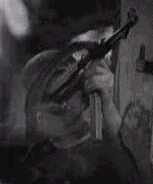 identical. An easy way to distinguish the two in pictures are the 4 horizontal
positive grooves on the magazine holder of the MP 40; the MP
38 does not have these. A late modification of the MP 40 was the MP
40/II that had two 32-round magazines located beside each other so
that the gunner could easily switch over to the second magazine after spending
the first one. Total production of MP 38 and MP 40 combined was 908,317.
identical. An easy way to distinguish the two in pictures are the 4 horizontal
positive grooves on the magazine holder of the MP 40; the MP
38 does not have these. A late modification of the MP 40 was the MP
40/II that had two 32-round magazines located beside each other so
that the gunner could easily switch over to the second magazine after spending
the first one. Total production of MP 38 and MP 40 combined was 908,317.
Practical range was below 200m, practical rate of fire below 100 rounds/min.
The weapon had a folding metal stock; it could not fix a bayonet or use
the Schiessbecher
rifle-grenade firing device but could be fitted with a Schalldämpfer
("silencer"), though this was very rare.
Technical data: length (MP 38) 62cm (MP 40) 63cm; length (stock unfolded)
83cm; barrel length (MP 38) 24cm (MP 40) 25cm; weight (MP 38 with empty
magazine) 4.22kg (MP 40 w/o magazine) 3.97kg; weight of loaded 32-round
magazine: 640g; theoretical rate of fire (system) 400 rounds per minute.
Ammunition: 9mmx19mm Parabellum; Penetration performance: dry
pinewood 23cm at 50m, 15cm at 200m; brick wall 4cm at 50m; sheet metal
2mm at 50m; steel armor of 2mm will only be dented.
The field gear of a soldier equipped with an MP 38 or MP 40 included two black leather triple magazine pouches holding one magazine each; later in the war they were often made of canvas. Together with the magazine in the weapon the total default ammo loadout for a fully supplied soldier therefore was 7 x 32 = 224 rounds. However, magazines were usually not fully loaded because the stress ecxerted onto the magazine spring and lips could lead to premature wear and ammo feeding jams.
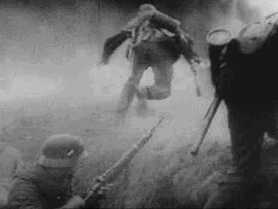 The
origins of the Mauser rifle family date back to the late 19th century.
The weapon was introduced by order of the german emperor in April 1898
as the Gewehr 98 after a decade-long debate. It was to become the
standard military rifle in many countries for many years to come; in germany
itself for over 50 years. They are still in use today with military units
in africa and southern america. A modified, shortened version of the rifle
was introduced into the Wehrmacht in 1935 as the standard rifle under the
designation Karabiner Modell Mauser 98 k ("multiple-shot carbine
model Mauser 98", "k" for "kurz" = "short"); it was also called Karabiner
98 k or simply Mauser 98 k.
The
origins of the Mauser rifle family date back to the late 19th century.
The weapon was introduced by order of the german emperor in April 1898
as the Gewehr 98 after a decade-long debate. It was to become the
standard military rifle in many countries for many years to come; in germany
itself for over 50 years. They are still in use today with military units
in africa and southern america. A modified, shortened version of the rifle
was introduced into the Wehrmacht in 1935 as the standard rifle under the
designation Karabiner Modell Mauser 98 k ("multiple-shot carbine
model Mauser 98", "k" for "kurz" = "short"); it was also called Karabiner
98 k or simply Mauser 98 k.
It was a bolt-action rifle with a fixed internal magazine for 5 rounds.
The 98 k could fix a bayonet, the Schiessbecher for firing rifle grenades
and different Zielfernrohre ("scopes") ranging from the Zielfernrohr
40 and Zf 41 with a zoom factor of 1.5 to the Zf 39 and
Zf
4 (also called Zf 43) with a 4x zoom . Six percent of the 98k
- production were to be fitted with a raail for scopes; this number of sniper
rifles could not be met.  The
german sniper with the most kills was Gefreiter Hetzenauer with a total
of 345 confirmed kills. The weapon at left shows a Mauser 98k with the
early Zf 39. The sights of the regular rifles could be adjusted from 100m
to 2000m in increments of 50m.
The
german sniper with the most kills was Gefreiter Hetzenauer with a total
of 345 confirmed kills. The weapon at left shows a Mauser 98k with the
early Zf 39. The sights of the regular rifles could be adjusted from 100m
to 2000m in increments of 50m.
Different modified versions of the Mauser rifle were produced, among
others special versions for paratroopers and mountain troops. Production
of the rifle was kept up all through the war. The german army entered WW
II with a total number of 2,769,533 Kar 98k. Another 7.540,058 were delivered
to the army until the end of the war (including 126,291 sniper modifications);
925,984 were delivered to the Luftwaffe, 191,250 to the navy and 62,600
to the SS (the SS received another 235,000 rifles, mainly Mauser-types,
from their own production), 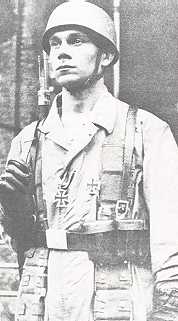 the
regular price for one Mauser 98k rifle was 70.- RM.
the
regular price for one Mauser 98k rifle was 70.- RM.
Technical data: length: 111cm; barrel length 60cm; weight empty (beech
stock) 3.9 - 4.1kg (walnut stock) 3.7 - 3.8kg; practical rate of fire 15
rounds per minute.
Ammunition: Infanteriepatrone
7,92x57
The ammo consisted of stripper clips holding 5 rounds; three such strips fit into a leather ammo pouch; ammo pouches were carried in connected sets of three which fit onto the belt of the field gear. A fully supplied regular german infantry soldier would carry either one or two triple ammo pouches for three strips per pouch, totaling for a default ammo loadout of 45 or 90 rounds excluding the ammo in the rifle.
Paratroopers were issued ammo bandoleers consisting of two rows of six pockets each connected by a canvas belt. Each pocket would hold one 5-round strip for the Mauser rifle, accounting for a total of 60 rounds.
The picture at right shows a young german paratrooper displaying both
the Iron Cross 2nd (attached to smock buttons) and 1st Class (attached
to left breast). He wears the typical paratrooper helmet and has his Mauser
Kar 98k shouldered.
Of interest is his combination of both the paratrooper canvas ammo
bandoleer and at least one standard triple leather ammo pouch atached to
his field gear belt.
The Gewehr 41 was germany's first attempt at a semi-automatic
rifle in the class of the american M1 Garand. The designation Gewehr 41
was given to two different weapons (although they look rather identical,
they differ a lot and are not based on each other). A first weapon made
by Mauser, the Gewehr 41 (M) ("rifle 41", "M"-suffix denominating
the producer Mauser) or G 41 (M) failed miserably, only 6,673 (other
sources: 14,334) were produced before production was halted, and of these
the army returned 1,673 as unusable. The story on the Gewehr 41 (W)
abbreviated G 41 (W) produced by Walther isn't much different; although
it had a much simpler and reliable system that also eased production, this
second G 41 still was both front-heavy and very sensitive to dirt because
of the gas-nozzle located at the muzzle. This unfortunate placement of
the gas-extraction at the muzzle  was
neccessified because the advising army weapon's bureau insisted that no
holes be drilled into the barrel itself (!). The weapon was very unpopular
among the troops. Still, 122,907 were built well into 1944.
was
neccessified because the advising army weapon's bureau insisted that no
holes be drilled into the barrel itself (!). The weapon was very unpopular
among the troops. Still, 122,907 were built well into 1944.
Both the the G 41 (M) and the G 41 (W) could be fixed with bayonets,
early models often were fitted with the small 1.5x scopes, late G 41 (W)
mounted the 4x scopes. The weapon at right shows a G 41 (W) with
Zielfernrohr
41 scope of 1.5x magnification. Neither model could use the Schiessbecher
rifle-grenade firing device. Both weapons featured an internal magazine
for 10 rounds, it was loaded with 2 of the regular Mauser 5-round clips;
the regular Mauser 98k ammo pouches were used.. Technical data for G
41 (W): length 114cm; barrel length 55cm; weight (empty) 4.6kg; Vo
745m/s; ammunition: Infanteriepatrone
7,92x57
After the weapon's bureau of the army nullified their requirement that
there be no holes drilled into the barrel itself for the gas-mechansim
to work for the automatic rifle system, the company Walther went on to
develop the Gewehr 43. This new semi-automatic rifle had the extraction
nozzle drilled into the barrel and featured a removable 10-round magazine.
The G 43 was
a beautiful design which was much cheaper and faster to produce. The weapon's
designation was later changed to Karabiner 43, abbreviated K
43, although the weapon really wasn't a carbine; it was envisioned
to replace the Mauser Karabiner 98k as the standard
infantry rifle. Production started in October 1943; total production until
the end of the war was 402,713 including at least 53,435 sniper rifles:
the well-designed and well-machined K 43 was a preferred sniper
weapon and was fitted with the Zielfernrohr 43, also called ZF
4, scope with a magnification of 4x. The weapon could use the Schiessbecher
device for firing rifle grenades and could use a Schalldämpfer
silencer; however, the G 43 could not fix a bayonet. Technical data: length
112cm; length barrel 55cm (versions with barrel lengths of 60cm, 65cm and
even 70cm existed); weight empty (w/o magazine and w/o scope) 4.1kg; weight
magazine (empty) 230g; weight Zielfernrohr 43 scope: 1.3kg; ammunition:
Infanteriepatrone
7,92x57; Vo 745m/s; practical rate of fire 30 rounds per minute;
was
a beautiful design which was much cheaper and faster to produce. The weapon's
designation was later changed to Karabiner 43, abbreviated K
43, although the weapon really wasn't a carbine; it was envisioned
to replace the Mauser Karabiner 98k as the standard
infantry rifle. Production started in October 1943; total production until
the end of the war was 402,713 including at least 53,435 sniper rifles:
the well-designed and well-machined K 43 was a preferred sniper
weapon and was fitted with the Zielfernrohr 43, also called ZF
4, scope with a magnification of 4x. The weapon could use the Schiessbecher
device for firing rifle grenades and could use a Schalldämpfer
silencer; however, the G 43 could not fix a bayonet. Technical data: length
112cm; length barrel 55cm (versions with barrel lengths of 60cm, 65cm and
even 70cm existed); weight empty (w/o magazine and w/o scope) 4.1kg; weight
magazine (empty) 230g; weight Zielfernrohr 43 scope: 1.3kg; ammunition:
Infanteriepatrone
7,92x57; Vo 745m/s; practical rate of fire 30 rounds per minute;
The Sturmgewehr 44 made history as the first real assault rifle;
in fact, the term "assault rifle" itself is a literal translation of this
weapon's 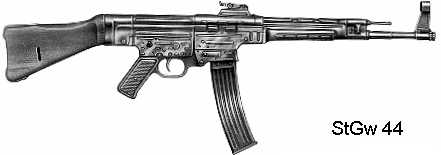 designation.
Obviously, the concept of the StGw influenced Mikhail Kalashnikov in his
development of the famous AK-47 assault rifle (although the AK has a system
of it's own right). The story of the Sturmgewehr is that of the
late success of an ingenious and right idea that prevailed despite all
efforts to stop it.
designation.
Obviously, the concept of the StGw influenced Mikhail Kalashnikov in his
development of the famous AK-47 assault rifle (although the AK has a system
of it's own right). The story of the Sturmgewehr is that of the
late success of an ingenious and right idea that prevailed despite all
efforts to stop it.
Many attempts had been made in several countries including germany
during the 1920ies to develop an automatic rifle that combined the characteristics
of the submachinegun - a high rate of fire and therefore fire volume -
with that of the then usual regular infantry rifle - accuracy and projectile
power - while at the same time eliminating the disadvantages of the respective
weapon types. Most of these attempts failed, because the conservative authorities
did not like the idea or -mostly- because these early weapons tried to
use the regular powerful rifle ammunition.
The german breakthrough therefore came when an order was given in April
1938 to develop a weapon that used the specially 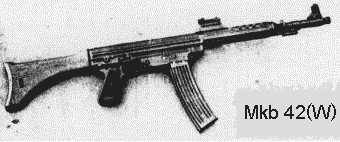 developed
Maschinenkarabiner-Patrone
7.92x33 or Kurzpatrone, later also called Pistolenpatrone
43, that was essentially a shortened
Mauser
7.9mm standard rifle cartridge filled with pistol ammunition powder.
Two notable designs emerged. The first was constructed by the company Walther
and was called Maschinenkarabiner 42 (W) or Mkb 42(W), the
other was designed by Hugo Schmeisser from the company Haenel in Suhl under
the designation Mkb 42(H). The two are easily discerned because
the Haenel-design has a second barrel housing the gas-operation channel
that reaches almost to the muzzle. The latter design was considered superior
and went into limited production for troop trials, total Mkb 42 production
was 11,833 weapons in late 1942 and early 1943. These were to be kept secret
from the high command, especially Hitler himself, as he was a strong opponent
to the idea not the least because he feared the large-scale introduction
of yet another ammunition type. Hitler nevertheless found out about the
limited production and ordered the it to be halted immediately.
developed
Maschinenkarabiner-Patrone
7.92x33 or Kurzpatrone, later also called Pistolenpatrone
43, that was essentially a shortened
Mauser
7.9mm standard rifle cartridge filled with pistol ammunition powder.
Two notable designs emerged. The first was constructed by the company Walther
and was called Maschinenkarabiner 42 (W) or Mkb 42(W), the
other was designed by Hugo Schmeisser from the company Haenel in Suhl under
the designation Mkb 42(H). The two are easily discerned because
the Haenel-design has a second barrel housing the gas-operation channel
that reaches almost to the muzzle. The latter design was considered superior
and went into limited production for troop trials, total Mkb 42 production
was 11,833 weapons in late 1942 and early 1943. These were to be kept secret
from the high command, especially Hitler himself, as he was a strong opponent
to the idea not the least because he feared the large-scale introduction
of yet another ammunition type. Hitler nevertheless found out about the
limited production and ordered the it to be halted immediately.
However, development continued under the cover of an alibi project
of producing a carbine for the accepted Mauser rifle ammunition at the
company Gustloff. Several aspects of the Walther Mkb 42(W) were incorporated,
the gas-operated mechanism was improved and the weapon was given the designation 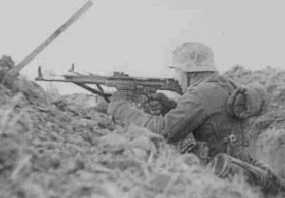 Maschinenkarabiner
43 (G) for the company Gustloff, again to deceive Hitler. Like the
chicken bone the witch is shown in Hänsel & Gretel, Adolf was
always shown the official Mkb 43(G) that was designed for the regular
Mauser 7.92mm rifle cartridge. The weapon that used the actual Kurzpatrone
was simply called MP 43 machine pistol in the hope that Hitler would
see this as a submachine gun.
Maschinenkarabiner
43 (G) for the company Gustloff, again to deceive Hitler. Like the
chicken bone the witch is shown in Hänsel & Gretel, Adolf was
always shown the official Mkb 43(G) that was designed for the regular
Mauser 7.92mm rifle cartridge. The weapon that used the actual Kurzpatrone
was simply called MP 43 machine pistol in the hope that Hitler would
see this as a submachine gun.
Eventually the truth surfaced and Hitler ordered the project stopped.
However, in the meantime the army that had used these weapons in the trials
was so enthusiastic about this new weapon that they eventually succeeded
in convincing Hitler to produce the weapon as a replacement for the MP
40. First large-scale use of this new weapon was with the 93rd ID 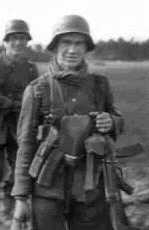 in
the northern sector of the eastern front. After small changes the weapon
was called MP 44. It was not until July 1944 when several Division
commanders personally begged Hitler in his headquarters that the weapon
was given production priority. In December of that same year the weapon
was given the suggestive name Sturmgewehr or Sturmgewehr 44,
abbreviated StG 44 or StGw 44. Total production of the MP
43 and MP 44 / Sturmgewehr was 425,977 at a price of 66.- RM for one Sturmgewehr
44.
in
the northern sector of the eastern front. After small changes the weapon
was called MP 44. It was not until July 1944 when several Division
commanders personally begged Hitler in his headquarters that the weapon
was given production priority. In December of that same year the weapon
was given the suggestive name Sturmgewehr or Sturmgewehr 44,
abbreviated StG 44 or StGw 44. Total production of the MP
43 and MP 44 / Sturmgewehr was 425,977 at a price of 66.- RM for one Sturmgewehr
44.
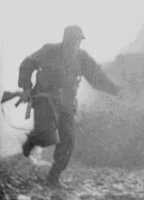 The weapon
is a gas-operated automatic weapon that can be fired both in selective
single-shot and in full automatic mode (toggled by a switch located on
the right side of the gun). Recoil reportedly is is arguably low. Because
the metal hand guard fore of the magazine heated up quickly when the weapon
was fired, gunners usually held the StGw 44 at the magazine instead of
the hot handguard. The StGw 44 features a 30-round curved magazine
and could be fitted with all known accessories: it could use bayonets or
silencers as well as the Schiessbecher
rifle grenade device or the ZF 4 scope. The regular sights can be
adjusted from 100m to 800m range.
The weapon
is a gas-operated automatic weapon that can be fired both in selective
single-shot and in full automatic mode (toggled by a switch located on
the right side of the gun). Recoil reportedly is is arguably low. Because
the metal hand guard fore of the magazine heated up quickly when the weapon
was fired, gunners usually held the StGw 44 at the magazine instead of
the hot handguard. The StGw 44 features a 30-round curved magazine
and could be fitted with all known accessories: it could use bayonets or
silencers as well as the Schiessbecher
rifle grenade device or the ZF 4 scope. The regular sights can be
adjusted from 100m to 800m range.
The Sturmgewehr 44 could also be fitted with ZF 1229 Vampir,
an infra-red night sighting device. The scope for the Vampir mounted
onto the StGw 44 weighed 2.3kg, the support devices were carried
in a rucksack and weighed 13kg. 310 of these night-fighting scopes were
produced at the company Leitz. Another intriguing invention was the Krummerlauf
("bent barrel"), a bent barrel with a persicope sighting device for shooting
around corners. This idea existed in several variants, an "I"-version for
infantry use and a "P" version for use in tanks (to cover the dead areas
in the close range around the tank to defend against assaulting infantry),
versions with 30°, 45°, 60° and 90°, and a 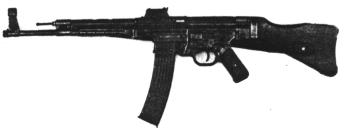 version
for the StGw 44 and one for the MG
42. Only the 30° "I" - version for the StGw 44 was produced
in any numbers.
version
for the StGw 44 and one for the MG
42. Only the 30° "I" - version for the StGw 44 was produced
in any numbers.
Technical data: length 94cm; barrel length 42cm; weight (w empty magazine
and sling) 4.62kg; weight of loaded 30-round magazine: 920g; theoretical
system rate of fire: 500 rounds/minuteM; practical rof in full automatic
mode 100 rpm; Vo 685 m/s.
Ammunition: Kurzpatrone 7.92x33; this ammunition is known under the designations Kurzpatrone, Infanteriepatrone 7,92mm PP 43 or as 7.92x33.It was a bottle-shaped cartridge, essentially a shortened regular Mauser 7.9mm rifle cartridge. The projectile had a caliber of 7.92mm and weighed 6.95g; the complete cartridge weighed 16.7g (incl. 1.4g powder) and developed a typical Eo of 1,500 Joule. Penetration performance: 25cm of birchwood at 50m; steel helmets were penetrated at ranges exceeding 600m. Total production of the Kurzpatrone ammunition was 822 mio. cartridges until March 1945.
A soldier equipped with the StGw 44 had six canvas magazine pouches in two sets of three as part of his field gear. Each magazine pouch held one 30-round magazine; together with the magazine atached to the weapon, the default ammo loadout for a fully equipped soldier was 7 magazines totaling 210 rounds.
The Fallschirmjägergewehr ("paratrooper rifle") is a large
automatic rifle firing the regular Mauser 7.9mm rifle ammunition. Regarding
size and role it is comparable to the american BAR and the british Bren,
therefore the weapon might also be classified as a light machine gun. One
of the main demands in the design order for an automatic rifle for airborne
troops was the prohibition to use critical material for the weapon. This
was met only party. The proposed design made by the company Rheinische
Metallwaren- und Maschinenfabrik (Rheinmetall) in Sömmerda under the
chief developer Louis Stange was accepted for a prototype series to prepare
mass production. Prototypes were finished in mid-1942; the weapon was officially
introduced into service as Fallschimrjägergewehr 42, abbreviated
FG
42, at the turn of year 1943/1944 but only for the Luftwaffe ("air
force") since the Heer ("army") was looking for a weapon using the new
Kurzpatrone (which eventually resulted in the Sturmgewehr 44). The production
was never able to meet requirements even 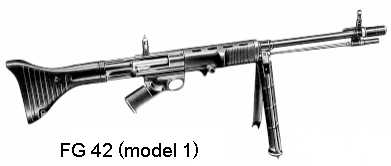 party.
Three easily discernible models of the FG 42 are differentiated:
model
1 has a pistol grip that is bent back at an extremely high and odd
angle; model 2 is the same as model 1 but the pistol grip is more
conventional and pointing down. Model 3, whose pistol grip is also
pointing down, features a unique hand guard fore of the barrel that has
13 deep but short grooves on the left side as opposed to the many thin
grooves on the left side of the hand guard on the other models 1 and 2.
Model 1 was produced only in very limited numbers for evaluation purposes;
model 2 remedied many of the problems encountered with the model 1, was
much simplified and produced in noticeable numbers. The definitive version
was model 3 which addressed the too strong recoil and lack of stability
during firing of the model 2. Total production numbers are differing depending
on the source; some state that no more than 7,000 FG 42 of all variants
were produced, while others say 5,000 or only a maximum of 1,500. The only
definitive production number is that of the FG 42 produced late
in the war for the army: 4,397.
party.
Three easily discernible models of the FG 42 are differentiated:
model
1 has a pistol grip that is bent back at an extremely high and odd
angle; model 2 is the same as model 1 but the pistol grip is more
conventional and pointing down. Model 3, whose pistol grip is also
pointing down, features a unique hand guard fore of the barrel that has
13 deep but short grooves on the left side as opposed to the many thin
grooves on the left side of the hand guard on the other models 1 and 2.
Model 1 was produced only in very limited numbers for evaluation purposes;
model 2 remedied many of the problems encountered with the model 1, was
much simplified and produced in noticeable numbers. The definitive version
was model 3 which addressed the too strong recoil and lack of stability
during firing of the model 2. Total production numbers are differing depending
on the source; some state that no more than 7,000 FG 42 of all variants
were produced, while others say 5,000 or only a maximum of 1,500. The only
definitive production number is that of the FG 42 produced late
in the war for the army: 4,397.
The weapon is gas-operated, the gas nozzle is located only a third
of barrel length from the breech, the second, thin "barrel" all the way
to the muzzle often seen in pictures is the bayonet in folded-back position.
The weapon is magazine fed from box-magaziones of 10 or 20 round capacity
attached to the right, the spent shells were expelled to the left. The
diopter sights range from 100m to 1,500m; all FG 42 could be fitted with
scopes and indeed it was often used as a sniper rifle. The weapon had an
integrated bipod and an integrated bayonet. The rifle-grenade device Gewehrgranatgerät
or Schiessbecher
could be attached to the FG 42. Technical data FG 42 model 3: length
97.5cm; barrel length (w/o muzzle break) 50cm; weight (empty) 4.98kg; weight
of empty 10-round magazine 190g (full: 460g); weight of empty 20-round
magazine 290g (full: 830g); ammunition: Mauser
Infanteriepatrone 7.92x57 in 10 and 20 round box magazines; system
rate of fire: 600/min; Vo 755m/s (other sources 685m/s, probably for other
ammunition type than
7.92x57
sS).
The magazines were caried in a variation of the standard paratrooper
Mauser 98k ammunition bandoleer; the canvas ammo bandoleer for the FG 42
had 2 sets of 4 larger pockets each holding one magazine; making for a
total default ammo loadout of 8 magazines of 20 rounds each totaling 160
rounds excluding the magazine in the weapon.
Previous Page : Tank Rifles Main Page Next Page : Rifle Grenades & Related Weapons
© 1998, 1999, 2000, 2001 created by M.Hofbauer August
29th 1998; document ver. 1.4 mod 150102
This page has been constructed with own material as far
as possible, the third party images and information used herein are public
domain to the best of my knowledge. The author went to considerable lengths
to ensure accordance with the rights of copyright owners where applicable;
respective consent is documented. If you feel injured in your rights by
/ take offense at - any part of this page's content contact
me immediately for redress / possible removal of the respective part.